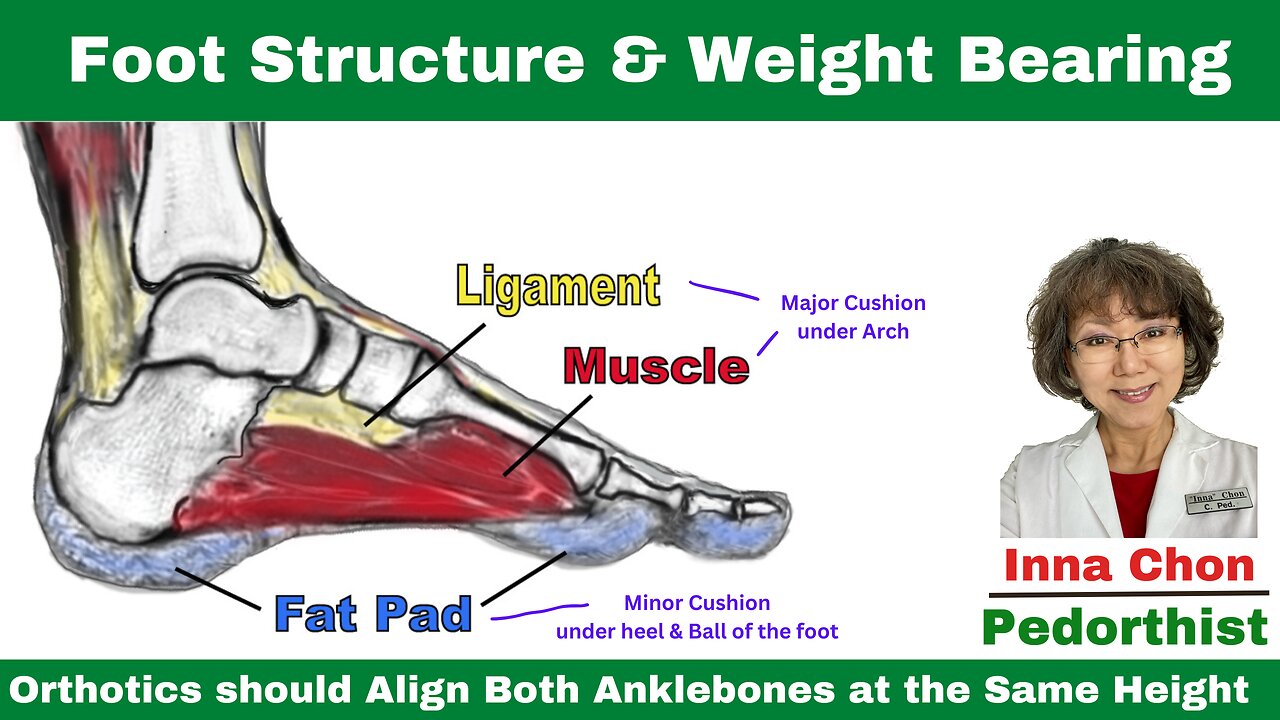Premium Only Content

Foot Structure & Weight-Bearing
The bottom of the foot, especially, the arch area, is designed to handle tremendous weight. However, on flat floors, we cannot use the arch part for weight-bearing that is designed to handle about 75% of the weight that falls to the bottom of the foot. As a result, nearly all of our body weight falls on the heel & the ball of the foot, which together designed to handle about 25% of the weight. This stresses the heel & ball of the foot by handling more than 3 time the weight they are structured to handle. Worse yet, each step we make on flat surfaces, the tarsal joint that forms the arch falls. This throws the entire foot bones out of alignment, including the anklebone on which the leg bone stands. Typically, both tarsal joints usually fall differently, causing one leg shorter than the other; different leg length tilts the hip bones; tilted hip bones cause scoliosis. It’s a simple chain reaction; making people to move out of alignment from the feet up. Over time, this leads to common foot problems like plantar fasciitis, heel spurs, neuromas, bunions, and hammer toes — as well as major joint issues such as arthritis, leg tendonitis, and even scoliosis.
The good news is, this can be prevented and improved.
The key is using the arch for its intended weight-bearing function by wearing orthotics that align both anklebones at the same height. This allows your body weight to be distributed evenly across the entire bottom of the foot, enabling you to stand and move in our body’s natural alignment from the feet upward.
The difference between moving on tilted anklebones versus aligned anklebones is significant. Understanding how misalignment affects the entire body is similar to recognizing the problems a car running with air leaking tires. The difference is, when it happens in our body, it’s a biomechanical issue—far more complex than mechanical problems in a man-made machine.
Orthotics that don’t properly align both anklebones at the same height can worsen foot and joint problems over time.
For more information on how to support your feet and major joints, visit:
www.feetbalanceorthotics.com
-
 1:13:18
1:13:18
Wendy Bell Radio
8 hours agoPet Talk With The Pet Doc
50.8K67 -
 5:54:39
5:54:39
dieseldesigns
6 hours agoExploring Labs In the DARK! // Abiotic factor
3.69K -
 LIVE
LIVE
BBQPenguin_
5 hours agoDragonball Z - The Android Saga
125 watching -
 LIVE
LIVE
Total Horse Channel
6 hours ago2025 URCHA Futurity | Derby & Horse Show | Saturday
37 watching -
 LIVE
LIVE
DynastyXL
5 hours ago🔴LIVE: Fortnite The Comeback Stream Starts Here🎃
48 watching -
 1:38:57
1:38:57
njgaming23
3 hours agoCoffee and Morning vibes #rumbletakeover
9.52K -
 1:09:19
1:09:19
Ami's House
2 days ago $18.19 earnedWhen Defending Israel Backfires: Are We Pushing Our Last Friends Away? With Karys Rhea
183K190 -
 8:13
8:13
WhaddoYouMeme
21 hours ago $1.57 earnedThis Gets More Tragic By The Second
14.3K10 -
 40:47
40:47
SouthernbelleReacts
3 days ago $1.94 earnedThe Faculty (1998) | Back-to-School Horror Movie Reaction | Alien Invasion in High School!
20.3K5 -
 6:58
6:58
Adam Does Movies
21 hours ago $0.60 earnedCaught Stealing - Movie Review
13.7K3